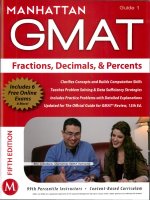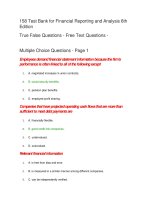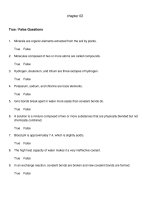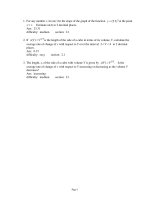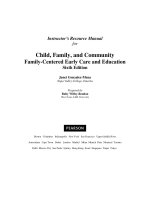Fractions, decimals, and percents, 6th edition
Bạn đang xem bản rút gọn của tài liệu. Xem và tải ngay bản đầy đủ của tài liệu tại đây (3.05 MB, 133 trang )
MANHATTAN PREP
Fractions, Decimals,
& Percents
GMAT Strategy Guide
This guide provides an in-depth look at the variety of GMAT questions that
test your knowledge of fractions, decimals, and percents. Learn to see the
connections among these part–whole relationships and practice
implementing strategic shortcuts.
guide 1
Fractions, Decimals, & Percents GMAT Strategy Guide, Sixth Edition
10-digit International Standard Book Number: 1-941234-02-X
13-digit International Standard Book Number: 978-1-941234-02-0
eISBN: 978-1-941234-23-5
Copyright © 2014 MG Prep, Inc.
ALL RIGHTS RESERVED. No part of this work may be reproduced or used in any form or by any means—graphic, electronic, or
mechanical, including photocopying, recording, taping, or web distribution—without the prior written permission of the publisher, MG
Prep, Inc.
Note: GMAT, Graduate Management Admission Test, Graduate Management Admission Council, and GMAC are all registered
trademarks of the Graduate Management Admission Council, which neither sponsors nor is affiliated in any way with this product.
Layout Design: Dan McNaney and Cathy Huang
Cover Design: Dan McNaney and Frank Callaghan
Cover Photography: Alli Ugosoli
INSTRUCTIONAL GUIDE SERIES
GMAT Roadmap
Number Properties
(ISBN: 978-1-941234-09-9)
(ISBN: 978-1-941234-05-1)
Fractions, Decimals, & Percents
Critical Reasoning
(ISBN: 978-1-941234-02-0)
(ISBN: 978-1-941234-01-3)
Algebra
Reading Comprehension
(ISBN: 978-1-941234-00-6)
(ISBN: 978-1-941234-06-8)
Word Problems
Sentence Correction
(ISBN: 978-1-941234-08-2)
(ISBN: 978-1-941234-07-5)
Geometry
Integrated Reasoning & Essay
(ISBN: 978-1-941234-03-7)
(ISBN: 978-1-941234-04-4)
SUPPLEMENTAL GUIDE SERIES
Math GMAT Supplement Guides
Verbal GMAT Supplement Guides
Foundations of GMAT Math
Foundations of GMAT Verbal
(ISBN: 978-1-935707-59-2)
(ISBN: 978-1-935707-01-9)
Advanced GMAT Quant
Official Guide Companion for Sentence Correction
(ISBN: 978-1-935707-15-8)
(ISBN: 978-1-937707-41-5)
Official Guide Companion
(ISBN: 978-0-984178-01-8)
December 2nd, 2014
Dear Student,
Thank you for picking up a copy of Fractions, Decimals, & Percents. I hope this book gives you just
the guidance you need to get the most out of your GMAT studies.
A great number of people were involved in the creation of the book you are holding. First and
foremost is Zeke Vanderhoek, the founder of Manhattan Prep. Zeke was a lone tutor in New York City
when he started the company in 2000. Now, well over a decade later, the company contributes to the
successes of thousands of students around the globe every year.
Our Manhattan Prep Strategy Guides are based on the continuing experiences of our instructors and
students. The overall vision of the 6th Edition GMAT guides was developed by Stacey Koprince,
Whitney Garner, and Dave Mahler over the course of many months; Stacey and Dave then led the
execution of that vision as the primary author and editor, respectively, of this book. Numerous other
instructors made contributions large and small, but I'd like to send particular thanks to Josh Braslow,
Kim Cabot, Dmitry Farber, Ron Purewal, Emily Meredith Sledge, and Ryan Starr. Dan McNaney and
Cathy Huang provided design and layout expertise as Dan managed book production, while Liz
Krisher made sure that all the moving pieces, both inside and outside of our company, came together
at just the right time. Finally, we are indebted to all of the Manhattan Prep students who have given us
feedback over the years. This book wouldn't be half of what it is without your voice.
At Manhattan Prep, we aspire to provide the best instructors and resources possible, and we hope
that you will find our commitment manifest in this book. We strive to keep our books free of errors,
but if you think we've goofed, please post to manhattanprep.com/GMAT/errata. If you have any
questions or comments in general, please email our Student Services team at
Or give us a shout at 212-721-7400 (or 800-576-4628 in the US or
Canada). I look forward to hearing from you.
Thanks again, and best of luck preparing for the GMAT!
Sincerely,
Chris Ryan
Vice President of Academics
Manhattan Prep
www.manhattanprep.com/gmat 138 West 25th Street, 7th Floor, New York, NY 10001 Tel: 212721-7400 Fax: 646-514-7425
TABLE of CONTENTS
Official Guide Problem Sets
1. FDPs
Problem Set
2. Digits & Decimals
Problem Set
3. Strategy: Test Cases
4. Fractions
Problem Set
5. Percents
Problem Set
6. Strategy: Choose Smart Numbers
Problem Set
7. Ratios
Problem Set
8. Strategy: Estimation
9. Extra FDPs
Problem Set
Appendix A: Data Sufficiency
Official Guide Problem Sets
As you work through this strategy guide, it is a very good idea to test your skills using official
problems that appeared on the real GMAT in the past. To help you with this step of your
studies, we have classified all of the problems from the three main Official Guide books and
devised some problem sets to accompany this book.
These problem sets live in your Manhattan GMAT Student Center so that they can be updated
whenever the test makers update their books. When you log into your Student Center, click on
the link for the Official Guide Problem Sets, found on your home page. Download them today!
The problem sets consist of four broad groups of questions:
1. A mid-term quiz: Take this quiz after completing Chapter 5 of this guide.
2. A final quiz: Take this quiz after completing this entire guide.
3. A full practice set of questions: If you are taking one of our classes, this is the
homework given on your syllabus, so just follow the syllabus assignments. If you are
not taking one of our classes, you can do this practice set whenever you feel that you
have a very solid understanding of the material taught in this guide.
4. A full reference list of all Official Guide problems that test the topics covered in this
strategy guide: Use these problems to test yourself on specific topics or to create
larger sets of mixed questions.
As you begin studying, try one problem at a time and review it thoroughly before moving on. In
the middle of your studies, attempt some mixed sets of problems from a small pool of topics
(the two quizzes we've devised for you are good examples of how to do this). Later in your
studies, mix topics from multiple guides and include some questions that you've chosen
randomly out of the Official Guide. This way, you'll learn to be prepared for anything!
Study Tips:
1. DO time yourself when answering questions.
2. DO cut yourself off and make a guess if a question is taking too long. You can try it
again later without a time limit, but first practice the behavior you want to exhibit on
the real test: let go and move on.
3. DON'T answer all of the Official Guide questions by topic or chapter at once. The
real test will toss topics at you in random order, and half of the battle is figuring out
what each new question is testing. Set yourself up to learn this when doing practice
sets.
ofChapter 1
Fractions, Decimals, & Percents
FDPs
In This Chapter…
Common FDP Equivalents
Converting Among Fractions, Decimals, and Percents
When to Use Which Form
Introduction to Estimation
Chapter 1
FDPs
FDPs stands for Fractions, Decimals, and Percents, the title of this book. The three forms are grouped
into one book because they are different ways to represent the same number. In fact, the GMAT often
mixes fractions, decimals, and percents in one problem. In order to achieve success with FDP
problems, you are going to need to shift amongst the three accurately and quickly.
A fraction consists of a numerator and a denominator:
A decimal uses place values:
0.5
A percent expresses a relationship between a number and 100: 50%
Each of these representations equals the same number but in a different form. Certain kinds of math
operations are easier to do in percent or decimal form than in fraction form and vice versa. Try this
problem:
Three sisters split a sum of money between them. The first sister receives
the second receives
of the total,
of the total, and the third receives the remaining $10. How many
dollars do the three sisters split?
(A) $10
(B) $20
(C) $30
(D) $40
(E) $50
To solve, you have to figure out what proportion of the money the first two sisters get, so that you
know what proportion the third sister's $10 represents. It's not too difficult to add up the relatively
simple fractions and , but harder fractions would make the work a lot more cumbersome. In
general, adding fractions is annoying because you have to find a common denominator.
On this problem, it's easier to convert to percentages. The first sister receives 50% of the money and
the second receives 25%, leaving 25% for the third sister. That 25% represents $10, so 100% is $40.
The correct answer is (D).
In order to do this kind of math quickly and easily, you'll need to know how to convert among
fractions, decimals, and percents. Luckily, certain common conversions are used repeatedly
throughout the GMAT. If you memorize these conversions, you'll get to skip the calculations. The next
two sections cover these topics.
Common FDP Equivalents
Save yourself time and trouble by memorizing the following common equivalents:
Fraction
1/1
1/2 = 2/4 = 3/6 = 4/8 = 5/10
3/2
Decimal
1
0.5
1.5
Percent
100%
50%
150%
1/4 = 2/8
3/4 = 6/8
5/4
7/4
0.25
0.75
1.25
1.75
25%
75%
125%
175%
1/8
3/8
5/8
7/8
0.125
0.375
0.625
0.875
12.5%
37.5%
62.5%
87.5%
1/5 = 2/10
2/5 = 4/10
3/5 = 6/10
4/5 = 8/10
0.2
0.4
0.6
0.8
20%
40%
60%
80%
1/10
3/10
7/10
9/10
0.10
0.3
0.7
0.9
10%
30%
70%
90%
1/3 = 2/6
2/3 = 4/6
0.3 ≈ 0.333
0.6 ≈ 0.666
≈ 33.3%
≈ 66.7%
4/3
1.3 ≈ 1.33
133%
1/6
5/6
1/9
0.16 ≈ 0.167
0.83 ≈ 0.833
0.11 ≈ 0.111
≈ 16.7%
≈ 83.3%
≈ 11.1%
1/100
1/50
1/25
1/20
0.01
0.02
0.04
0.05
1%
2%
4%
5%
Converting Among Fractions, Decimals, and Percents
The chart below summarizes various methods to convert among fractions, decimals, and percents (for
any conversions that you haven't memorized!).
You'll get plenty of practice with these skills throughout this book, but if you'd like some more, see
the FDPs section in the Foundations of GMAT Math Strategy Guide.
When to Use Which Form
As you saw in the “three sisters” problem, percentages (or decimals) are easier to add and subtract.
Fractions, on the other hand, work very well with multiplication and division.
If you have already memorized the given fraction, decimal, and percent conversions, you can move
among the forms quickly. If not, you may have to decide between taking the time to convert from one
form to the other and working the problem using the less convenient form (e.g., dividing fractions to
produce decimals or expressing those fractions with a common denominator in order to add).
Try this problem:
What is 37.5% of 240?
If you convert the percent to a decimal and multiply, you will have to do a fair bit of arithmetic:
Try something a bit harder:
A dress is marked up
to a final price of $140. What is the original price of the
dress?
is on the memorization list; it is equal to . Adding
as multiplying by
of a number to itself is the same thing
. Call the original price x and set up an equation to solve.
.
Therefore, the original price is $120.
As you've seen, decimals and percents work very well with addition and subtraction: you don't have
to find common denominators! For this same reason, decimals and percents are also preferred when
you want to compare numbers or perform certain estimations. For example, what is
?
You can find common denominators, but both fractions are on your “conversions to memorize” list:
If the answers are in fraction form, convert back:
In some cases, you may decide to stick with the given form rather than convert to another form. If you
do have numbers that are easy to convert, though, then use fractions for multiplication and division
and use percents or decimals for addition and subtraction, as well as for estimating or comparing
numbers.
Introduction to Estimation
FDP conversions can sometimes help you to estimate your way to an answer.
Try this problem:
65% of the students at a particular school take language classes. Of those students, 40%
have studied more than one language. If there are 300 students at the school, how many
have studied more than one language?
(A) 78
(B) 102
(C) 120
Step 1: Glance, Read, Jot: What's going on?
Glance at the problem: is it Problem Solving or Data Sufficiency? If it's Problem Solving, glance at
the answers. Are they numerical or do they contain variables? Are they “easy” numbers or hard ones?
Close together or far apart? If they're far apart, you can estimate!
As you read, jot down any obvious information:
Step 2: Reflect, Organize: What's my plan?
Okay, 300 is the starting point, but 65% is a bit annoying. You can figure out that number. Do you
want to take the time to do so?
If you've noticed that the answers are decently far apart, you know you can estimate. Since 65% is
very close to , it is a far easier number to use (especially with 300 as the starting point!).
Step 3: Work: Solve!
of 300 is 200
Note that you rounded up, so your answer will be a little higher than the official number.
To calculate 40% of that number, use one of two methods:
Method 1: For multiplication, convert to fractions:
Method 2: Find 10% of the number, then multiply by 4 to get 40%:
10% of 200 = 20, so 40% = 20 × 4 = 80
Approximately 80 students have studied more than one language. The correct answer is (A).
This book will teach you how to perform proper calculations (and you do need to learn how!), but
you should also keep an eye out for opportunities to estimate on GMAT problems. You'll learn
multiple strategies when you get to Chapter 8, “Strategy: Estimation.”
Problem Set
1. Express the following as fractions and simplify:
2. Express the following as fractions and simplify:
3. Express the following as decimals:
4. Express the following as decimals:
5. Express the following as percents:
6. Express the following as percents:
7. Order from least to greatest:
8. 200 is 16% of what number?
9. What number is 62.5% of 192?
Solutions
1. To convert a decimal to a fraction, write it over the appropriate power of 10 and simplify:
2. To convert a percent to a fraction, write it over a denominator of 100 and simplify:
3. To convert a fraction to a decimal, divide the numerator by the denominator:
It often helps to simplify the fraction before you divide:
4. To convert a mixed number to a decimal, simplify the mixed number first, if needed:
5. To convert a fraction to a percent, rewrite the fraction with a denominator of 100:
Or, convert the fraction to a decimal and shift the decimal point two places to the right:
6. To convert a decimal to a percent, shift the decimal point two places to the right:
80.4 = 8,040%
0.0007 = 0.07%
7.
To order from least to greatest, express all the terms in the same form:
8. 1,250: This is a percent vs. decimal conversion problem. If you simply recognize that 16% =
, this problem will be a lot easier:
, so
. Dividing out 200 ÷ 0.16 will probably take longer to
complete.
9. 120: This is a percent vs. decimal conversion problem. If you simply recognize that
, this problem will be a lot easier:
× 240 will take much longer to complete.
. Multiplying 0.625
ofChapter 2
Fractions, Decimals, & Percents
Digits & Decimals
In This Chapter…
Digits
Decimals
Place Value
Rounding to the Nearest Place Value
Powers of 10: Shifting the Decimal
Decimal Operations
Chapter 2
Digits & Decimals
Digits
Every number is composed of digits. There are only ten digits in our number system: 0, 1, 2, 3, 4, 5,
6, 7, 8, 9. The term digit refers to one building block of a number; it does not refer to a number itself.
For example, 356 is a number composed of three digits: 3, 5, and 6.
Integers can be classified by the number of digits they contain. For example:
2, 7, and −8 are each single-digit numbers (they are each composed of one digit).
43, 63, and −14 are each double-digit numbers (composed of two digits).
500,000 and −468,024 are each six-digit numbers (composed of six digits).
789,526,622 is a nine-digit number (composed of nine digits).
Non-integers are not generally classified by the number of digits they contain, since you can always
add any number of zeroes at the end, on the right side of the decimal point:
9.1 = 9.10 = 9.100
Decimals
GMAT math goes beyond an understanding of the properties of integers (which include the counting
numbers, such as 1, 2, 3, their negative counterparts, such as −1, −2, −3, and the number 0). The
GMAT also tests your ability to understand the numbers that fall in between the integers: decimals.
For example, the decimal 6.3 falls between the integers 6 and 7:
Some useful groupings of decimals include:
Group
Examples
Decimals less than −1:
−3.65, −12.01, −145.9
Decimals between −1 and 0: −0.65, −0.8912, −0.076
Decimals between 0 and 1: 0.65, 0.8912, 0.076
Decimals greater than 1:
3.65, 12.01, 145.9
Note that an integer can be expressed as a decimal by adding the decimal point and the digit 0. For
example:
8 = 8.0
−123 = −123.0
400 = 400.0
Place Value
Every digit in a number has a particular place value depending on its location within the number. For
example, in the number 452, the digit 2 is in the ones (or “units”) place, the digit 5 is in the tens place,
and the digit 4 is in the hundreds place. The name of each location corresponds to the value of that
place. Thus:
The 2 is worth two ones, or 2 (i.e., 2 × 1);
The 5 is worth five tens, or 50 (i.e., 5 × 10); and
The 4 is worth four hundreds, or 400 (i.e., 4 × 100).
You can now write the number 452 as the sum of these products:
452 = 4 × 100 + 5 × 10 + 2 × 1

